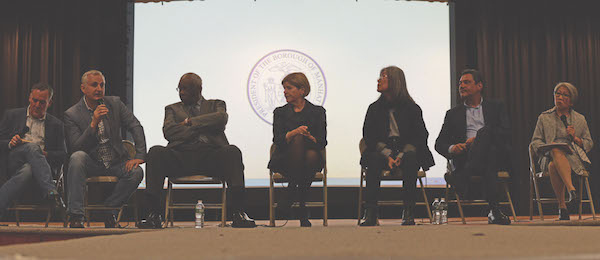
BY JACKSON CHEN | Organizations that are working to preserve the fabric of the Garment District are offering alternative proposals to what they see as an unfriendly zoning change being pushed by the city.
The fact that criticism is coming from many quarters was clear in an April 24 forum and panel discussion convened by Borough President Gale Brewer, who has called on the de Blasio administration to go back to square one in its planning about the cluster of Midtown blocks roughly from West 35th to 40th Streets between Broadway and Ninth Avenue.
Some garment industry officials are urging a fundamental rethinking of the city’s apparent goal of shifting the industry’s center to Brooklyn, and even leaders in that borough agree that the rezoning should be guided in part by an advisory group made up of stakeholders.
The intensifying discussion of substitute proposals for the Garment District’s rezoning follows a heated Community Board 5 meeting in late March at which the city’s Economic Development Corporation (EDC) and Department of City Planning presented their ideas, which includes the elimination of a 1:1 preservation requirement, created in 1987, under which every new square foot of office space is required to be matched by preservation of manufacturing space.
A key component of the city’s rezoning vision is to stem the encroachment of hotels into the district by requiring new ones to seek a special permit. The proposal is aimed principally at catering to the new breed of smaller enterprises that have been moving in — in advertising, technology, media, and the non-profit sphere.
With the EDC continuing to invite community feedback before moving forward, it is finding that critics are not shy about pointing to the lack of stakeholder input and to the plan’s overall misguidedness. Brewer’s forum drew a wide array of traditional Garment District players, including designers, manufacturers, and unionized workers.
According to Steve Epstein, representing the Theatrical Wardrobe Local 764, the district, though not the center of manufacturing it once was, continues to offer him a cluster of convenient outlets for his supply needs.
“We’re talking about an efficiency that does not exist anywhere else,” Epstein said. “That does make me more competitive and it makes the product… much more exciting and beautiful for the consumer.”
Joe Ferrara, president of the New York Garment Center Supplier Association and one of the panelists, charged the EDC’s proposal would “deport the Garment Center to Brooklyn.”
While separate from its Manhattan rezoning push, the EDC has aggressively promoted the city’s efforts to create two garment hubs in Brooklyn.
Yeohlee Teng, a designer who owns YEOHLEE Inc., said that investing in Brooklyn is a great idea, but that the city should offer the same incentives in what remains of Manhattan’s Garment District. Teng, who also teaches at the Parsons School of Design, said many of her students are able to complete projects due to the school’s proximity to the Garment District.
“The importance of the Garment District lies in New York’s claim to be the fashion capital of the world,” Teng said. “Now you can only be the fashion capital of the world if you keep incubating great new designs that are made in New York.”
Rather than focusing on improvements to the proposal laid out by the city, with what the Garment Center Supplier Association sees as clear inducements for the industry to move to Brooklyn, the group has submitted a completely alternative plan to the EDC. Ferrara explained that the association’s proposal calls for setting aside 500,000 square feet of space in the district dedicated exclusively to manufacturing use. Under this alternative, a city entity or a non-profit would own or manage the space and allocate it among industry manufacturers.
“[This] would provide enough of an anchor to the industry to survive,” Ferrara said of the half-million square-foot set-aside. “We expect it would build upon that anchor… It’s not intended to include the entire industry, it’s simply so that enough of it can be anchored in the district.”
CB5 chair Vikki Barbero, in an April 12 letter, requested that both the EDC and City Planning put the Garment District rezoning effort on hold while a steering committee spends up to nine months exploring proposals for moving forward.
“We’re eager to roll up our sleeves and get to work but we cannot responsibly proceed on the current path,” Barbero said in her letter. “We need to do better for the sake of the thousands of people who depend on this district for their livelihood.”
Brewer, who by the time of her forum had already asked the city to start the process over with more input from stakeholders, repeated that call, warning that otherwise the industry would inevitably be shoved out of Midtown.
In an April 14 letter addressed to city agencies, Brooklyn Borough President Eric Adams — whose borough critics of the EDC plan charge would be the winner from that approach — joined Brewer and the chairs of Manhattan Community Boards 4 and 5 in requesting that a steering committee be formed.
According to an EDC spokesperson, the agency is considering the proposal for a steering committee and reviewing the New York Garment Center Supplier Association proposal regarding Manhattan manufacturing space, though that statement was grudging, at best.
“The sponsors of the forum offer no realistic path to preserving and strengthening one of New York City’s iconic industries,” said Stephanie Baez, EDC’s vice president of public affairs. “This is about safeguarding a job-intensive sector for future generations by taking action today.”
































